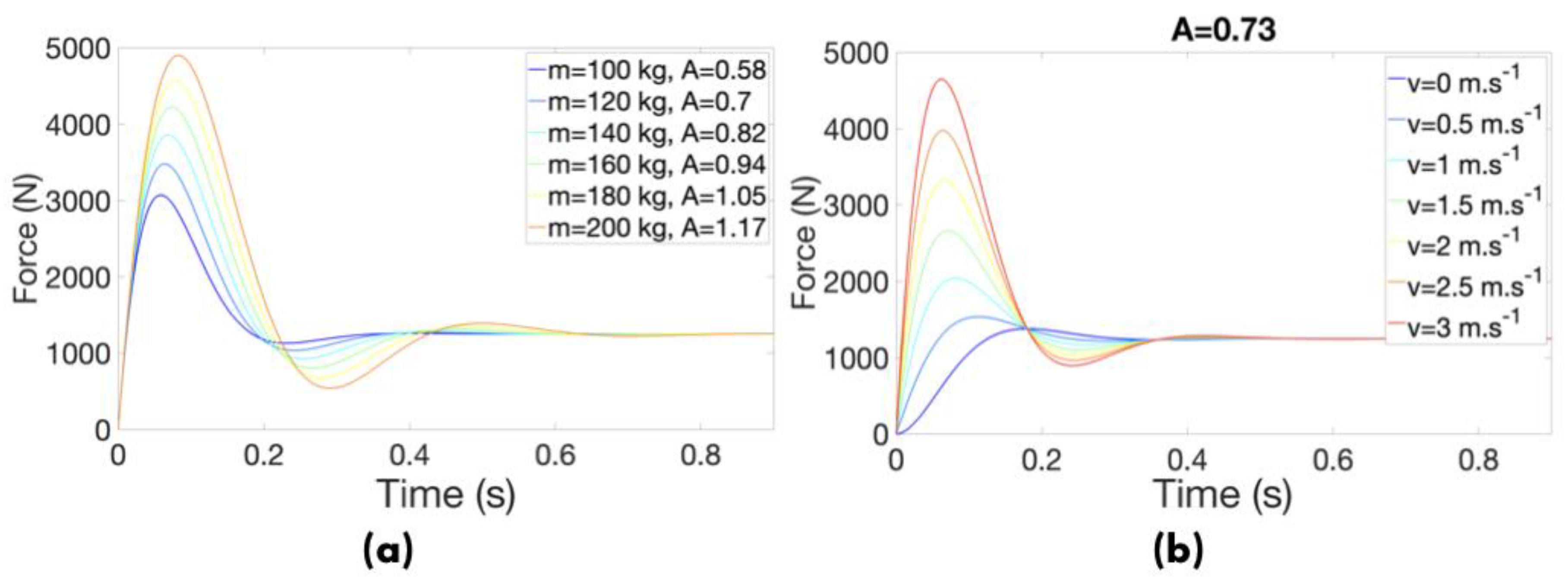Peak Compression Force Physics in Rugby Union Scrum †
Abstract
:1. Introduction
- “Crouch”—front rows are crouching to face the opponents at the same height;
- “Bind”—each prop binds to her/his opponent who is in front of her/him;
- “Set”—when both sides are stable, packs engage.
2. Experimental Study
3. Results
4. MacMahon Look-Alike Model for a Single Player and Discussion
5. Conclusions
Acknowledgments
Conflicts of Interest
References
- Laws of the Game Rugby Union. Available online: https://laws.worldrugby.org/?law=19&amends=off&language=EN (accessed on 10 February 2020).
- Scher, A.T. Rugby injuries to the cervical spinal cord. S. Afr. Med. J. 1977, 51, 473–475. [Google Scholar] [PubMed]
- Swaminathan, R.; Williams, J.M.; Jones, M.D.; Theobald, P.S. A kinematic analysis of the spine during rugby scrummaging on natural and synthetic turfs. J. Sports Sci. 2016, 34, 1058–1066. [Google Scholar] [CrossRef] [PubMed]
- Wetzler, M.J.; Akpata, T.; Laughlin, W.; Levy, A.S. Occurrence of cervical spine injuries during the rugby scrum. Am. J. Sports Med. 1998, 26, 177–180. [Google Scholar] [CrossRef] [PubMed]
- Milburn, P.D. The kinetics of rugby union scrummaging. J. Sports Sci. 1990, 8, 47–60. [Google Scholar] [CrossRef] [PubMed]
- Olds, T. The evolution of physique in male rugby union players in the twentieth century. J. Sports Sci. 2001, 19, 253–262. [Google Scholar] [CrossRef] [PubMed]
- Hill, N.E. Changes in northern hemisphere male international rugby union players’ body mass and height between 1955 and 2015. BMJ Open Sport Exerc. Med. 2018, 4, 1. [Google Scholar] [CrossRef] [PubMed]
- Quarrie, K.L.; Wilson, B.D. Force production in the rugby union scrum. J. Sports Sci. 2000, 18, 237–246. [Google Scholar] [CrossRef] [PubMed]
- Preatoni, E.; Stokes, K.A.; England, M.E.; Trewartha, G. Engagement techniques and playing level impact the biomechanical demands on rugby forwards during machine-based scrummaging. Br. J. Sports Med. 2015, 49, 520–528. [Google Scholar] [CrossRef] [PubMed]
- Cazzola, D.; Preatoni, E.; Stokes, K.; England, M.E.; Trewartha, G. A modified prebind engagement process reduces biomechanical loading on front row players during scrummaging: A cross-sectional study of 11 elite teams. Br. J. Sports Med. 2015, 49, 541–546. [Google Scholar] [CrossRef] [PubMed]
- Gianotti, S.; Hume, P.A.; Hopkins, W.G.; Harawira, J.; Truman, R. Interim evaluation of the effect of a new scrum law on neck and back injuries in rugby union. Br. J. Sports Med. 2008, 42, 427–430. [Google Scholar] [CrossRef] [PubMed]
- Preatoni, E.; Stokes, K.A.; England, M.E.; Trewartha, G. The influence of playing level on the biomechanical demands experienced by rugby union forwards during machine scrummaging. Scand. J. Med. Sci. Sports 2013, 23, e178–e184. [Google Scholar] [CrossRef] [PubMed]
- Preatoni, E.; Wallbaum, A.; Gathercole, N.; Coombes, S.; Stokes, K.A.; Trewartha, G. An integrated measurement system for analysing impact biomechanics in the rugby scrum. J. Sports Eng. Technol. 2012, 226, 266–273. [Google Scholar] [CrossRef]
- McMahon, T.A. Muscles, Reflexes and Locomotion; Princeton University Press: Princeton, NJ, USA, 1984. [Google Scholar]




| Year of Publication, Pack Level | 1990 [5], International | 2000 [8], Community | 2015 [9], International |
|---|---|---|---|
| Fpeak (kg) | 814 | 12.3 × 102 | CTPE: 16.8 × 102; CTS: 16.8 × 102; FoldIn: 878 |
| Pack weight (kg) | 686 ** | 774 ** | 893 |
| Position (Number of Players) | Loosehead Props * (2) | Hookers Tighthead Props (3) | Locks (3) | Flankers * (2) | Number-8 (1) |
|---|---|---|---|---|---|
| Weight (kg) | 112 ± 4.0 | 119 ± 18 | 127 ± 15 | 110 ± 4.0 | 108 |
| Fmean (kg) | 182 ± 20 | 201 ± 25 | 194 ± 5.7 | 174 ± 52 | 186 |
| Player’s Position | Lock-5 | Lock-4 | Hooker | Number-8 | Hooker 2 | Tight-Head Prop |
|---|---|---|---|---|---|---|
| Engagement speed (m·s−1) | 1.2 | 1.4 | 1.1/1.7 | 1.9 | 2.2 | 3 |
| Fpeak (kg) | 271 | 466 | 285/331 | 347 | 363 | 417 |
Publisher’s Note: MDPI stays neutral with regard to jurisdictional claims in published maps and institutional affiliations. |
© 2020 by the authors. Licensee MDPI, Basel, Switzerland. This article is an open access article distributed under the terms and conditions of the Creative Commons Attribution (CC BY) license (https://creativecommons.org/licenses/by/4.0/).
Share and Cite
Lallemand, B.; Clanet, C.; Blanchard, S.; Noriega, P.; Piscione, J.; Chaplain, O.; Retière, D.; Cohen, C. Peak Compression Force Physics in Rugby Union Scrum. Proceedings 2020, 49, 151. https://doi.org/10.3390/proceedings2020049151
Lallemand B, Clanet C, Blanchard S, Noriega P, Piscione J, Chaplain O, Retière D, Cohen C. Peak Compression Force Physics in Rugby Union Scrum. Proceedings. 2020; 49(1):151. https://doi.org/10.3390/proceedings2020049151
Chicago/Turabian StyleLallemand, Benjamin, Christophe Clanet, Sylvain Blanchard, Patricio Noriega, Julien Piscione, Olivier Chaplain, Didier Retière, and Caroline Cohen. 2020. "Peak Compression Force Physics in Rugby Union Scrum" Proceedings 49, no. 1: 151. https://doi.org/10.3390/proceedings2020049151




